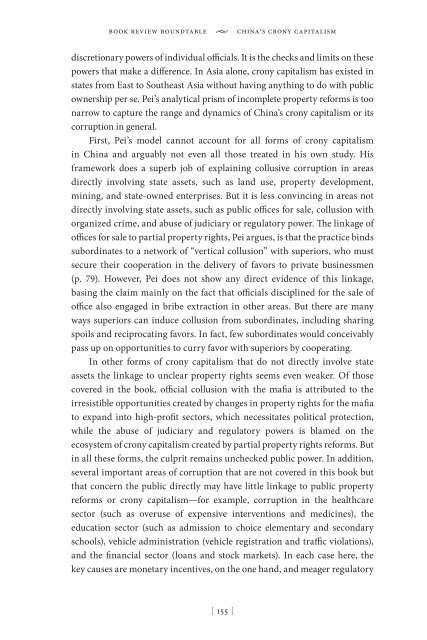2jBVKVf
2jBVKVf
2jBVKVf
You also want an ePaper? Increase the reach of your titles
YUMPU automatically turns print PDFs into web optimized ePapers that Google loves.
ook review roundtable • china’s crony capitalism<br />
discretionary powers of individual officials. It is the checks and limits on these<br />
powers that make a difference. In Asia alone, crony capitalism has existed in<br />
states from East to Southeast Asia without having anything to do with public<br />
ownership per se. Pei’s analytical prism of incomplete property reforms is too<br />
narrow to capture the range and dynamics of China’s crony capitalism or its<br />
corruption in general.<br />
First, Pei’s model cannot account for all forms of crony capitalism<br />
in China and arguably not even all those treated in his own study. His<br />
framework does a superb job of explaining collusive corruption in areas<br />
directly involving state assets, such as land use, property development,<br />
mining, and state-owned enterprises. But it is less convincing in areas not<br />
directly involving state assets, such as public offices for sale, collusion with<br />
organized crime, and abuse of judiciary or regulatory power. The linkage of<br />
offices for sale to partial property rights, Pei argues, is that the practice binds<br />
subordinates to a network of “vertical collusion” with superiors, who must<br />
secure their cooperation in the delivery of favors to private businessmen<br />
(p. 79). However, Pei does not show any direct evidence of this linkage,<br />
basing the claim mainly on the fact that officials disciplined for the sale of<br />
office also engaged in bribe extraction in other areas. But there are many<br />
ways superiors can induce collusion from subordinates, including sharing<br />
spoils and reciprocating favors. In fact, few subordinates would conceivably<br />
pass up on opportunities to curry favor with superiors by cooperating.<br />
In other forms of crony capitalism that do not directly involve state<br />
assets the linkage to unclear property rights seems even weaker. Of those<br />
covered in the book, official collusion with the mafia is attributed to the<br />
irresistible opportunities created by changes in property rights for the mafia<br />
to expand into high-profit sectors, which necessitates political protection,<br />
while the abuse of judiciary and regulatory powers is blamed on the<br />
ecosystem of crony capitalism created by partial property rights reforms. But<br />
in all these forms, the culprit remains unchecked public power. In addition,<br />
several important areas of corruption that are not covered in this book but<br />
that concern the public directly may have little linkage to public property<br />
reforms or crony capitalism—for example, corruption in the healthcare<br />
sector (such as overuse of expensive interventions and medicines), the<br />
education sector (such as admission to choice elementary and secondary<br />
schools), vehicle administration (vehicle registration and traffic violations),<br />
and the financial sector (loans and stock markets). In each case here, the<br />
key causes are monetary incentives, on the one hand, and meager regulatory<br />
[ 155 ]


